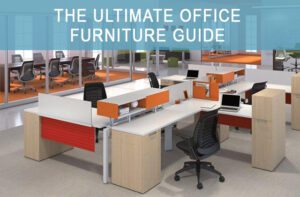One of the most significant decisions you’ll make as a manager or owner of a firm is selecting the appropriate office furniture. However, it’s not just about aesthetics or comfort. The right office furniture can significantly impact your employee’s productivity and overall well-being. With that in mind, Offcemate has put together this guide to help you remember the five key points you should always remember before purchasing. From ergonomics to durability, we’ve got you covered. So, continue reading to ensure you make the best choice for your office.
- Determine your needs: Consider your unique needs before purchasing furniture for your home or office. Think about things like the amount of room you have, the furniture’s utility, and its intended use.
- Budget: Set a reasonable spending limit when buying furnishings. This will enable you to reduce your alternatives and make sure you don’t spend too much. Remember to account for the upfront cost and any potential maintenance or replacement costs.
- Quality and durability: Invest in well-made furniture built to last. Look for materials that are known for their durability, such as solid wood or high-quality metal frames. Check for the furniture’s construction, joints, and finishes to ensure they are sturdy and well-crafted.
- Comfort: Comfort is crucial, whether it’s a sofa for your living room or an office chair. Test the furniture before purchasing to ensure it provides adequate support and ergonomic design, especially for items you’ll be using for extended periods.
- Style and aesthetics: Consider the overall style and aesthetics of your home or office space when choosing furniture. Opt for designs and colors that complement the existing decor and create a cohesive look. However, remember that trends may change, so choose timeless pieces that won’t quickly go out of style.
- Size and scale: Measure your space accurately before buying furniture to ensure it fits properly. Consider the dimensions of doorways, hallways, and elevators that the furniture must pass through during delivery. Oversized or undersized furniture can make a room feel cramped or empty, so strike the right balance.
- Functionality and storage: Evaluate how the furniture will serve your needs. For example, if you’re buying a bed, consider whether it has built-in storage options. Look for desks or tables with drawers or shelves that can help you stay organized. Furniture that offers both functionality and storage can maximize the utility of your space.
- Maintenance requirements: Different furniture types may require varying maintenance levels. Consider factors like cleaning, polishing, and upkeep when making your decision. If you have time constraints or prefer low-maintenance options, choose furniture that fits your lifestyle.
- Brand reputation and reviews: Research the reputation and reviews of the furniture brand or manufacturer you’re considering. Look for customer feedback on the company’s quality, durability, and customer service. Reliable brands often offer warranties or guarantees, providing added assurance for your purchase.
- Eco-friendliness: If sustainability is important, consider furniture made from environmentally friendly materials or manufactured through sustainable practices. Consider certifications such as Forest Stewardship Council (FSC) for wood products or GREENGUARD for indoor air quality. Choosing eco-friendly options helps reduce your environmental impact.
Final Words
Remember, these points are general guidelines, and your needs and preferences may vary. Take your time to research and compare options before making a final decision, ensuring that the furniture you choose enhances your home or office space.








